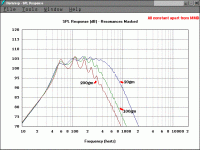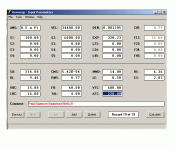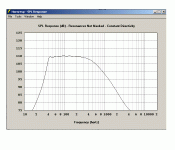Thanks, Jan, this is very helpful. What kind of parameters do you suggest I look for in a bass horn driver?
Can anyone suggest some good candidates?
The tangband looks good but shipping of that driver from Taiwan is 8x the cost of the driver!
My understanding is that TS parameters should look like this:
fs > 30 Hz
Qts ~ 0.35
BL high
xmax 12mm
Ideally it should be not too expensive in case it doesn't work out too well!
Can anyone suggest some good candidates?
The tangband looks good but shipping of that driver from Taiwan is 8x the cost of the driver!
My understanding is that TS parameters should look like this:
fs > 30 Hz
Qts ~ 0.35
BL high
xmax 12mm
Ideally it should be not too expensive in case it doesn't work out too well!
Hi Paul.
This is very dependent on what you want to do.
Also sometimes drivers that one normally doesn't think would work
still works pretty good, since most horns end up like compromises anyway.
Generally I like High Bl, alnico, underhung coil, stiff membrane,
Fs in the lower end of the passband.
Most important still is that the horn and driver can be made to work together.
The drivers I use are mostly modified to suit the intended horn.
Lots of trial and error. On both horn and driver
Sorry, I don't know much about present offerings.
That sucks. Australia is such a big country, surely there must be suitable drivers available in the pro market?
Well, the drivers used in the Labhorn don't have typical horn-driver-parameters,
but are still work very good in that horn. In that light first find out what passband you want
to cover, and then a suitable driver and horn combination must be found.
I don't have any fast answers, unfortunately.
Maybe some of the more theorethically ( sp?) minded persons on this list can help you?
cheers
paulspencer said:What kind of parameters do you suggest I look for in a bass horn driver?
This is very dependent on what you want to do.
Also sometimes drivers that one normally doesn't think would work
still works pretty good, since most horns end up like compromises anyway.
Generally I like High Bl, alnico, underhung coil, stiff membrane,
Fs in the lower end of the passband.
Most important still is that the horn and driver can be made to work together.
The drivers I use are mostly modified to suit the intended horn.
Lots of trial and error. On both horn and driver
Can anyone suggest some good candidates?
Sorry, I don't know much about present offerings.
The tangband looks good but shipping of that driver from Taiwan is 8x the cost of the driver!
That sucks. Australia is such a big country, surely there must be suitable drivers available in the pro market?
My understanding is that TS parameters should look like this:
fs > 30 Hz
Qts ~ 0.35
BL high
xmax 12mm
Ideally it should be not too expensive in case it doesn't work out too well!
Well, the drivers used in the Labhorn don't have typical horn-driver-parameters,
but are still work very good in that horn. In that light first find out what passband you want
to cover, and then a suitable driver and horn combination must be found.
I don't have any fast answers, unfortunately.
Maybe some of the more theorethically ( sp?) minded persons on this list can help you?
cheers
That's exactly what it is. When the horn mouth is too small or too few are used together, it turns into a really underdamped waveguide instead of an acoustic impedance coupler. Try corner loading (modeling in 1/2pi space) and you will find that corners really do well to extend the mouths of horns. Perhaps the most interesting example of this is the TLAH from Bill Fitzmaurice, which mounts up in the corner and uses the corner itself as a really big flared waveguide. It uses something like nine NSB full range drivers from Parts Express. The most interesting of the TLAH applications was one person's install in a low-level sound reinforcement application for a small church. When covered with white grille cloth, they look like acoustic treatment panels.
Like a Klipsch horn?which mounts up in the corner and uses the corner itself as a really big flared waveguide
1/8 thTry corner loading (modeling in 1/2pi space)
Wkr Johan
Make the lower F3 40hz not any lower,thats just making a massive box.
Perhaps consider a locally available 10"? Here I plan on trying a parallel imported JBL GTO1204.JBL,kenwood,pioneer 10" and 12" car units with 'in between' Qts,low fs and high Xmax.
Attached : different moving mass. See ripple in band.
Perhaps consider a locally available 10"? Here I plan on trying a parallel imported JBL GTO1204.JBL,kenwood,pioneer 10" and 12" car units with 'in between' Qts,low fs and high Xmax.
Attached : different moving mass. See ripple in band.
Attachments
Hi all
I agree with Mike that it would pay get get drivers locally,
better to spend hard earned money on quality drivers
than freight.
Mike's example shows what happens when horn and driver are not working properly together, allthough a 8" driver
with moving mass of 200g is not something one would realisticly use as a midhorn driver.
What brands of drivers can you get locally, Paul?
cheers
I agree with Mike that it would pay get get drivers locally,
better to spend hard earned money on quality drivers
than freight.
Mike's example shows what happens when horn and driver are not working properly together, allthough a 8" driver
with moving mass of 200g is not something one would realisticly use as a midhorn driver.
What brands of drivers can you get locally, Paul?
cheers
Hmmm, very interesting chart!
Thanks for the tip, I'll start looking a bit more into some local drivers ... perhaps even some peerless car subs ...
Jan,
It just so happens that overseas drivers imported can be cheaper at times than getting them via local distributors, or at times they are better value. I got my AV12s for about the cost of the Shiva bought locally.
I can get very good prices on Vifa, Peerless and Scan Speak. Can get Seas here for a bit more. RE audio, Adire. I haven't looked much into local suppliers of pro stuff, but I'd say most of the main brands I could get like Eminence, Beyma, JBL etc. A lot of them at PE are reasonably priced.
Why do you say an 8" isn't a good idea?
My main criteria for drivers would be cost, output, horn suitability (whatever that means), and would prefer the driver to have good distortion performance before horn loading.
Thanks for the tip, I'll start looking a bit more into some local drivers ... perhaps even some peerless car subs ...
Jan,
It just so happens that overseas drivers imported can be cheaper at times than getting them via local distributors, or at times they are better value. I got my AV12s for about the cost of the Shiva bought locally.
I can get very good prices on Vifa, Peerless and Scan Speak. Can get Seas here for a bit more. RE audio, Adire. I haven't looked much into local suppliers of pro stuff, but I'd say most of the main brands I could get like Eminence, Beyma, JBL etc. A lot of them at PE are reasonably priced.
Why do you say an 8" isn't a good idea?
My main criteria for drivers would be cost, output, horn suitability (whatever that means), and would prefer the driver to have good distortion performance before horn loading.
Hi Paul
Ahh , then you have a pretty good selection to chose from.
If I were you I would spend some time checking out drivers
and see what you can do with them in Hornresponse.
Sorry, I was unclear. An 8" driver is a splendid idea for a midbasshorn. But not an 8" driver with MMD of 200g.
Max 15- 20g would be more suitable IMHO.
EDIT:
I would check out the pro sector if I were you .
A pro 8" or 10" driver usually have specs much better suited to
hornlading.
cheers
paulspencer said:Jan,
I can get very good prices on Vifa, Peerless and Scan Speak. Can get Seas here for a bit more. RE audio, Adire. I haven't looked much into local suppliers of pro stuff, but I'd say most of the main brands I could get like Eminence, Beyma, JBL etc. A lot of them at PE are reasonably priced.
Ahh , then you have a pretty good selection to chose from.
If I were you I would spend some time checking out drivers
and see what you can do with them in Hornresponse.
Why do you say an 8" isn't a good idea?
Sorry, I was unclear. An 8" driver is a splendid idea for a midbasshorn. But not an 8" driver with MMD of 200g.
Max 15- 20g would be more suitable IMHO.
EDIT:
I would check out the pro sector if I were you .
A pro 8" or 10" driver usually have specs much better suited to
hornlading.
cheers
The biggest problem I'm having is IMO "compression ratio!" The designs seem to call for a very small throat, ie 10% of SD, which is a compression ratio of 10 right? As far as I'm aware, this is too high! Make it closer to SD and the response is no longer flat! 
How high can I go in compression ratio?
What are the problems if I go too high?

How high can I go in compression ratio?
What are the problems if I go too high?
Hi
You'd get a smaller horn, but also more ripple.
Huh?
SD on the Beta 8 is 214 and the throat in the example is 100. That's not what I would call high compression ratio.
cheers
mike.e said:Thats still a large horn slowmotion : Id consider one with half the mouth area,and correspondingly less path length.
You'd get a smaller horn, but also more ripple.
paulspencer said:The biggest problem I'm having is IMO "compression ratio!" The designs seem to call for a very small throat, ie 10% of SD, which is a compression ratio of 10 right? As far as I'm aware, this is too high! Make it closer to SD and the response is no longer flat! :
Huh?
SD on the Beta 8 is 214 and the throat in the example is 100. That's not what I would call high compression ratio.
cheers
Jan, I was referring more to the results I get from the "Hypex designer" feature. I tend to find better simulated results also from a high compression ratio. I'm trying to find out what my limits are here ...
even the example you gave has a compresssion ratio greater than 2 which I thought was considered a safe limit, unless I got it wrong.
even the example you gave has a compresssion ratio greater than 2 which I thought was considered a safe limit, unless I got it wrong.
Greets!
10:1?!!!!! Altec compression drivers are this high and look at the construction/horn size required to get a 500 Hz/2nd order Fc. Extrapolating to 40 Hz would require a motor hoist to put in position and turn a large personal fortune into a small one to make.
In the 'good ol' days', horn drivers/lens were initially designed as theoretically ideal full size exponential since sound pressure is exponential (1/f) and if it was acoustically long enough it generated a smooth response over the desired BW with a second order roll off at both ends once reactance annulled. If it was too long or there wasn't a suitable driver or it had too much gain and/or BW for the app, a 'slice' of it was used that best met the performance goals with the desired driver(s), ergo the early truncated designs from Altec, etc..
Anyway, in today's 'techo world' Leach's math will give you your answers. Remember, any driver can be optimally horn loaded over some BW at some efficiency, so the main question is, does its specs meet the needs of the desired performance goals? If not, use his math to find the ideal driver and if it doesn't exist in this reality, then find the closest to it and sim how much it compromises your goals, etc.. At least you won't have to actually cobble together/measure an old chicken coop full of proofs-of-concepts like I did to get yours.
GM
10:1?!!!!! Altec compression drivers are this high and look at the construction/horn size required to get a 500 Hz/2nd order Fc. Extrapolating to 40 Hz would require a motor hoist to put in position and turn a large personal fortune into a small one to make.
In the 'good ol' days', horn drivers/lens were initially designed as theoretically ideal full size exponential since sound pressure is exponential (1/f) and if it was acoustically long enough it generated a smooth response over the desired BW with a second order roll off at both ends once reactance annulled. If it was too long or there wasn't a suitable driver or it had too much gain and/or BW for the app, a 'slice' of it was used that best met the performance goals with the desired driver(s), ergo the early truncated designs from Altec, etc..
Anyway, in today's 'techo world' Leach's math will give you your answers. Remember, any driver can be optimally horn loaded over some BW at some efficiency, so the main question is, does its specs meet the needs of the desired performance goals? If not, use his math to find the ideal driver and if it doesn't exist in this reality, then find the closest to it and sim how much it compromises your goals, etc.. At least you won't have to actually cobble together/measure an old chicken coop full of proofs-of-concepts like I did to get yours.
GM
Hi Paul, all
Here's a link to a webpage by John Sheerin:
http://ldsg.snippets.org/HORNS/design.html
The page has further links to Leach's page.
cheers
Here's a link to a webpage by John Sheerin:
http://ldsg.snippets.org/HORNS/design.html
The page has further links to Leach's page.
cheers
Its interesting how the equations reccomend often,a high compression ratio which isnt normally practical.
Biggest basshorns
http://www.geocities.com/xobt/basshorns/basshorns.htm:smash:
Biggest basshorns
http://www.geocities.com/xobt/basshorns/basshorns.htm:smash:

- Status
- This old topic is closed. If you want to reopen this topic, contact a moderator using the "Report Post" button.
- Home
- Loudspeakers
- Subwoofers
- Comments on bass horn sim in horn response


